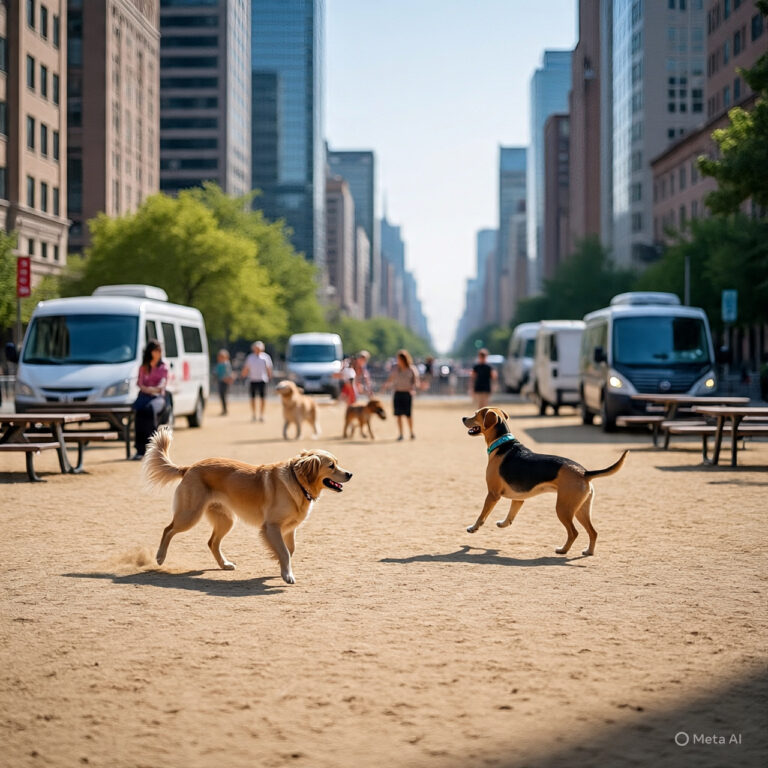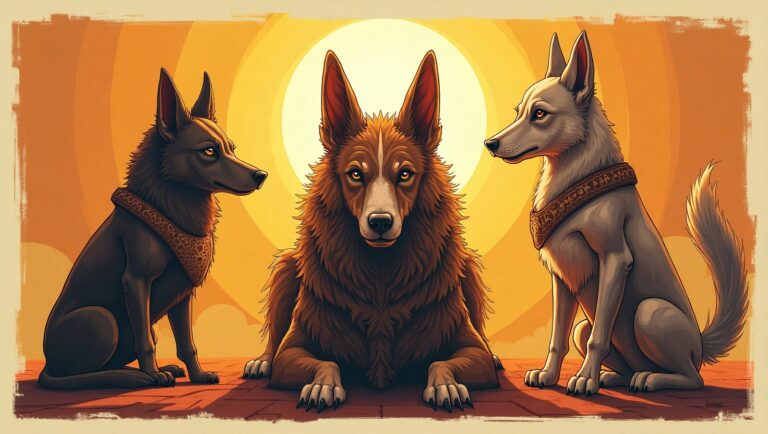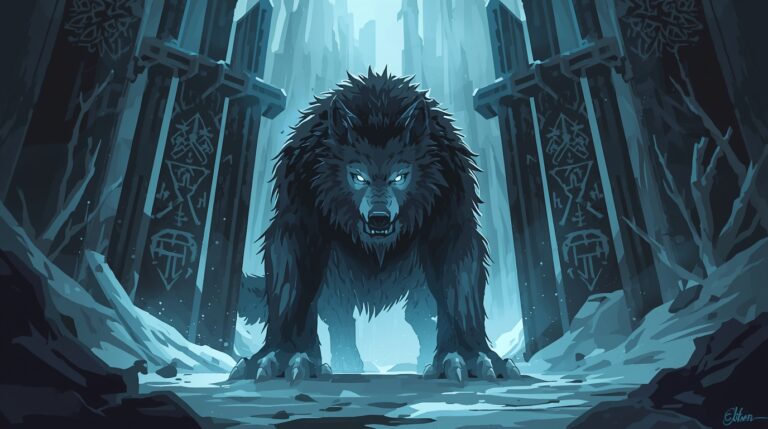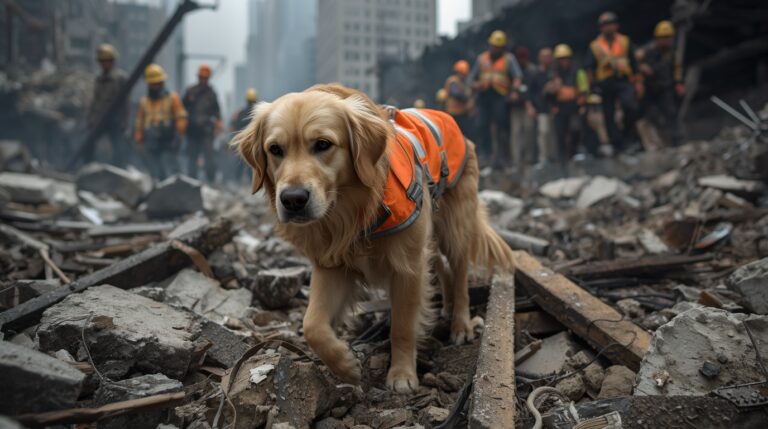Sacred Dogs in Tibetan and Mongolian Cultures
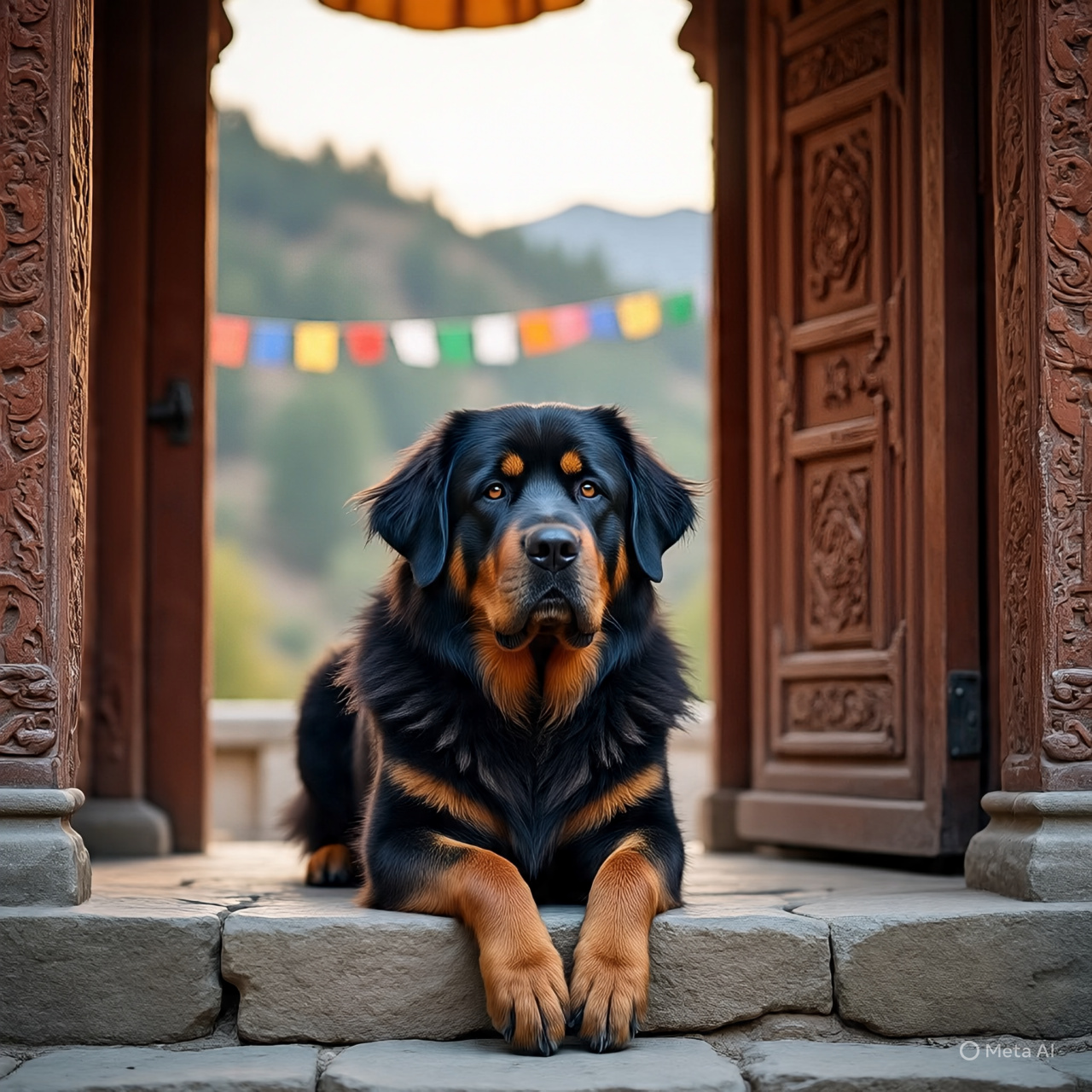
Introduction
Across the high plateaus of Tibet and the vast steppes of Mongolia, dogs have long held sacred status in spiritual and cultural traditions. These are not merely working animals or loyal companions but symbolic beings deeply woven into cosmology, ritual practice, and ancestral beliefs. The dog stands as a threshold figure—guarding monastery gates, following nomads through wilderness, appearing in shamanic dreams, and playing a central role in rituals that connect the living with the divine. From the fierce Tibetan Mastiff to the stoic Mongolian Bankhar, these animals are revered as protectors of the home, the spirit, and the sacred land.
The Spiritual Landscape of Tibet and Mongolia
To understand the sacred status of dogs in these cultures, one must first grasp the spiritual frameworks of Tibet and Mongolia. Tibetan spirituality is rooted in a combination of Buddhism, particularly the Vajrayana or Tantric form, and Bön, the indigenous pre-Buddhist religion that emphasizes nature spirits, sacred geography, and ritual offerings. Mongolia, while influenced by Tibetan Buddhism historically, also preserved older animistic and shamanistic practices associated with Tengriism, the worship of the eternal blue sky and the spirits of nature and ancestors. In both traditions, animals are not merely physical beings but spiritual actors, often acting as messengers, guardians, or manifestations of karmic forces. Dogs, in particular, are seen as liminal creatures—standing between the seen and unseen worlds.
The Role of the Dog in Tibetan Myth and Belief
Dogs in Tibetan folklore are often connected to sacred protection and divine loyalty. In village legends and temple myths, dogs are said to bark at negative spirits, protect sacred relics, and remain vigilant against supernatural intruders. One widely shared belief holds that dogs have the ability to perceive demons, wandering ghosts, and hungry spirits (preta) that remain invisible to humans. Stories also exist of dogs guiding lost monks or travelers through the Himalayas, their presence interpreted as a sign of protection from deities. Some temples even recount tales of dogs who refused to leave the bodies of deceased lamas, staying at their side in mourning—a gesture seen as spiritually meaningful.
Tibetan Mastiffs as Sacred Guardians
Perhaps the most iconic sacred dog in Tibet is the Tibetan Mastiff—a large, powerful guardian breed known for its intelligence, independence, and ferocity. These dogs are traditionally kept by nomadic families and monasteries to guard livestock and sacred spaces. In Tibetan culture, their physical might is not merely utilitarian; it is symbolic of their spiritual authority as protectors of the Dharma (cosmic law). Tibetan Mastiffs are often considered emanations of protective deities, and in some regions, stories claim they were created by bodhisattvas to guard against demonic forces. Their presence at monastery entrances is not just for physical security—it is a metaphysical defense, maintaining the purity of sacred grounds.
Dogs in Sky Burial Rituals
Tibet’s famous sky burial practice—where the deceased are placed on mountaintops to be consumed by vultures—is deeply tied to the Buddhist view of impermanence and the cycle of rebirth. While birds are the primary agents in this ritual, dogs also play an important but less visible role. In some regions, dogs are present near sky burial sites as natural scavengers. However, their presence is seen symbolically. Because dogs are considered liminal animals, their nearness during a soul’s transition from body to spirit is thought to anchor the space, ensuring that malevolent forces do not interfere with the karmic process. Some monks believe that a dog’s howl during a sky burial is a signal of spirit passage or a warning of spiritual imbalance.
Canine Symbolism in Bön and Tibetan Folk Religion
In Bön tradition and rural Tibetan folk practices, dogs are regarded as sacred boundary-keepers and spirit watchers. Altars in mountain villages sometimes include effigies or carvings of dogs, offered ritual food or butter lamps in exchange for protection. It is believed that dogs can be reincarnations of human beings, especially monks or spiritually inclined individuals. Some households consult village shamans when a dog behaves strangely—interpreting odd behavior as karmic unrest or ancestral return. In certain rites, dogs are bathed, blessed, and given ceremonial scarves to affirm their role as guardians of the home and spiritual wardens.
also read this Dogs in Mythology, Religion & Folklore
Dogs and the Dalai Lama
Historical accounts of the Dalai Lamas often mention their relationships with dogs, especially Tibetan Mastiffs and Lhasa Apsos. These dogs were not only companions but seen as auspicious beings, their presence associated with protection, balance, and longevity. In certain biographies, dogs are noted to have barked during critical spiritual events or at the death of high lamas, signaling karmic transitions. It is also believed that some reincarnated lamas (tulkus) form immediate bonds with dogs upon recognition, indicating shared karmic history. The dog in this context becomes more than a pet—it is an indicator of past lives and spiritual proximity.
Dog Imagery in Tibetan Art and Thangka
In Tibetan thangka paintings, guardian dogs occasionally appear alongside wrathful deities or protective spirits. While not as common as dragons or snow lions, dogs do show up at the feet of deities or near the corners of mandalas, often painted in white, black, or multicolored forms, each with specific symbolic meaning. A white dog represents purity and divine guidance, black symbolizes protection from evil, and multicolored dogs may reflect cosmic harmony. In architectural art, carvings of dogs are placed near entranceways, especially in temples, to invoke their guarding energy against negative forces. Some statues even include inscriptions dedicating the dog spirit to watch over the Dharma realm.
Mongolian Nomadic Culture and the Sacred Dog
In Mongolia, dogs are not only part of the nomadic household—they are spiritual protectors of the camp (ger). No yurt is considered safe without a Bankhar dog watching its threshold. Mongolian beliefs hold that a dog sees evil spirits and malicious ancestors and will alert the family with a specific type of bark. These dogs are trained to stay near the fire, where the hearth spirit resides, and are often given a place near the altar. To disrespect a dog, especially by kicking or yelling, is considered not just rude but spiritually dangerous. Many Mongolian families offer a small portion of their meal to the dog each day as an act of ancestral respect.
The Mongolian Bankhar Dog: History and Role
The Bankhar dog, a now-endangered Mongolian breed, is known for its loyalty, intelligence, and incredible endurance in extreme climates. Traditionally raised with livestock, these dogs develop deep emotional and spiritual bonds with their human families. In folklore, the Bankhar is described as a soul guardian, accompanying the spirit of a deceased family member on the first part of their journey to the afterlife. In ancient times, Bankhars were buried near or with their masters, a practice indicating that they were considered co-travelers in life and death. Modern conservationists now work to preserve the breed not only for ecological reasons but because of their cultural and spiritual significance.
Dogs in Tengriism and Mongolian Shamanism
In Tengriism, the ancient spiritual system of the Mongols, all life is interconnected under the gaze of Tengri, the eternal blue sky deity. Dogs are believed to be totemic animals associated with loyalty, weather omens, and spiritual warnings. Shamanic rituals often involve animal spirits, and the dog is sometimes invoked to guide or guard the shaman during soul journeys. A barking dog during a ritual is taken seriously, interpreted as an ancestral voice or spiritual intrusion. Some shamans keep dogs near their sacred drums or altars, believing they help maintain spiritual cleanliness. Their role is both practical and supernatural, guarding both physical and metaphysical boundaries.
Dogs and Death in Mongolian Culture
In both nomadic and settled Mongolian traditions, the dog plays a central role during death and mourning. It is said that when someone is near death, the family dog will refuse food, howl in specific rhythms, or sit facing the mountains. After a death, the dog’s behavior is closely watched—if the dog leaves the yurt or refuses to return, it may be signaling that the spirit has not found peace. Some families perform small purification rituals involving incense or milk offerings to cleanse the dog’s aura, ensuring it does not carry residual spiritual tension. In certain cases, shamans may communicate with the dog to understand the needs of the deceased spirit.
Dog Guardianship and Liminal Spaces
Dogs in both Tibetan and Mongolian cultures are considered liminal beings—they guard doorways, mountain passes, and the entrances to sacred or dangerous sites. Their role in these spaces is not accidental. Mountains are seen as homes of deities and spirits, and dogs are left to watch trails to prevent spirit interference. Similarly, dogs sit at the threshold of the yurt, a place symbolically loaded as the entrance to the family soul. Even at festivals or large gatherings, dogs may walk through sacred circles or campfires, considered a sign that spirits are pleased or that no harmful energy is present.
Genghis Khan and the Sacred Dog Legend
Legends of Genghis Khan often include sacred dogs who warned him of assassination attempts, guided his army through enemy terrain, or barked to alert him of spiritual danger. In one story, a black dog followed his caravan for three days and nights, refusing food. Afterward, a nearby village was discovered to be harboring hostile forces. The dog disappeared after the warning, believed to be a spirit guardian sent by Tengri. In Mongolian literature and oral tradition, dogs often represent divine loyalty and foresight, qualities deeply respected by warrior leaders and shamans alike.
Ceremonial Uses of Dogs in Festivals and Rites
During Tibetan and Mongolian New Year celebrations, dogs are sometimes included in purification rites. Families may wash their dogs and offer them butter sculptures or barley flour as part of their household blessings. In older rituals, dog figurines made of dough or wood were buried near doorways or tied to yurt poles as guardians against evil spirits. While sacrificial rituals involving dogs existed in ancient times, modern traditions focus more on symbolic offerings and prayers. Dogs are praised in folk songs, their loyalty toasted with yak butter tea, and their protection invoked during community rituals.
The Snow Lion vs. The Dog: Symbolic Dualities
The Snow Lion, a mythical creature in Tibetan lore, represents fearlessness and joy in the service of Dharma. The dog, by contrast, represents earthly vigilance, loyalty, and spiritual transition. Some thangkas feature both creatures in symbolic balance—the lion in the sky, the dog on the ground—highlighting the dual role of divine courage and faithful protection. While the Snow Lion is mythic, the dog is real, making its symbolism accessible and grounded, especially for nomadic peoples and rural monks who rely on dogs for survival.
Dogs in Mongolian and Tibetan Dreams and Omens
Dreams of dogs are considered powerful in both Tibetan and Mongolian traditions. A white dog appearing in a dream may signify an upcoming spiritual journey, while a barking dog in the distance could be a message from an ancestor. Shamans may interpret these dreams based on color, behavior, and location. A dog that runs ahead in a dream is guiding the dreamer through karma or danger, while a dog that stands still may be blocking negative energy. These interpretations form a major part of spiritual consultations in rural communities, where dreams serve as prophetic maps.
Contemporary Views: Sacred Dogs Today
Even in modern Tibet and Mongolia, dogs retain their spiritual importance. In urban areas, some monasteries still keep Tibetan Mastiffs not just as guards, but as blessed animals. In rural Mongolia, efforts to preserve the Bankhar breed include educating nomads about the cultural and spiritual significance of these dogs. Animal welfare groups have collaborated with Buddhist monks to promote compassionate treatment of dogs, aligning with the Buddhist principle of non-harming. Across both cultures, sacred dogs continue to be cultural heritage bearers, walking the line between the spiritual and the practical in everyday life.
Symbolic Interpretations of Dog Behavior
Specific dog behaviors are watched closely for spiritual meaning. A dog that howls facing the east might signal ancestral visitation. One that refuses to enter the home could be warning of spiritual impurity. Dogs that dig under altars or sit on prayer mats are not scolded but seen as having sensed the presence of divine energy. In rituals, if a dog barks during a chant, the practitioner may pause and reflect—it is considered a divine interruption or validation. These nuanced interpretations affirm the dog’s place as active communicators in the spiritual world.
Conclusion
In Tibetan and Mongolian cultures, dogs are not merely animals—they are guardians of karma, protectors of sacred space, and messengers between worlds. Whether patrolling monastery steps, lying by the family altar, or appearing in dreams, these revered animals embody the profound relationship between the human and the spiritual. The dog’s loyalty, perceptiveness, and courage make it an eternal symbol of spiritual vigilance in two of Asia’s richest and most enduring cultural landscapes.
